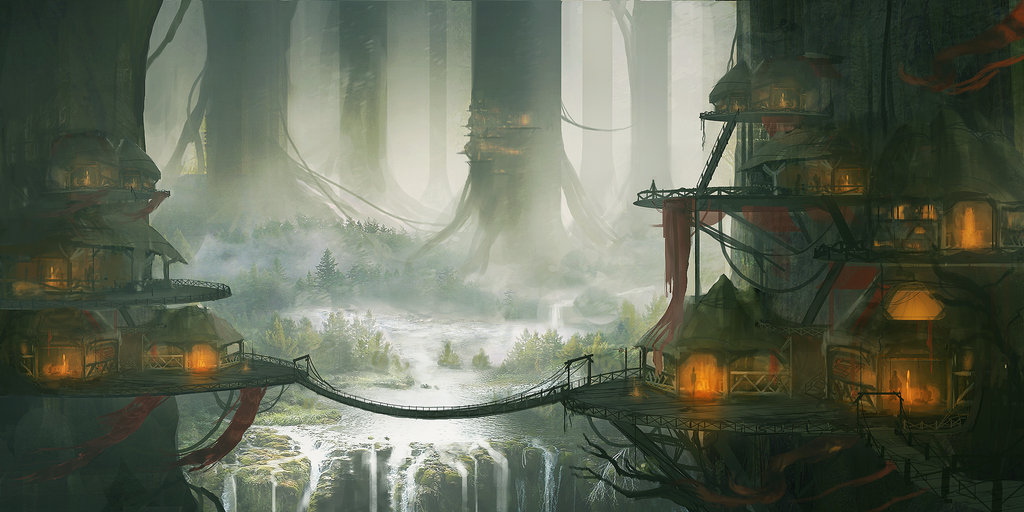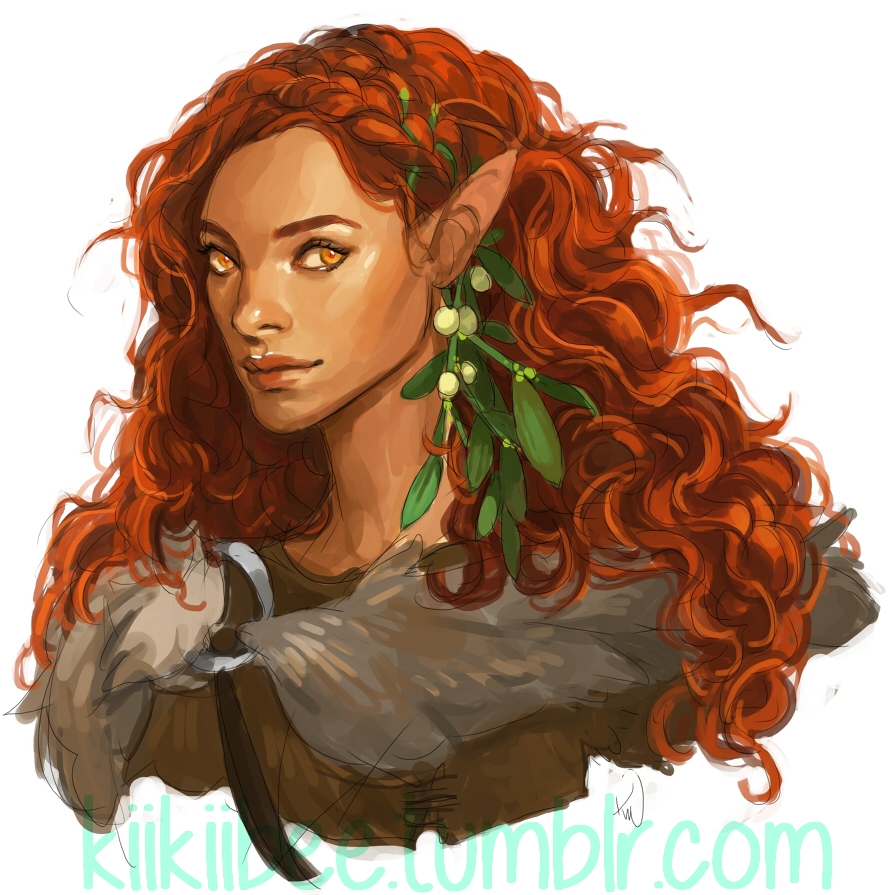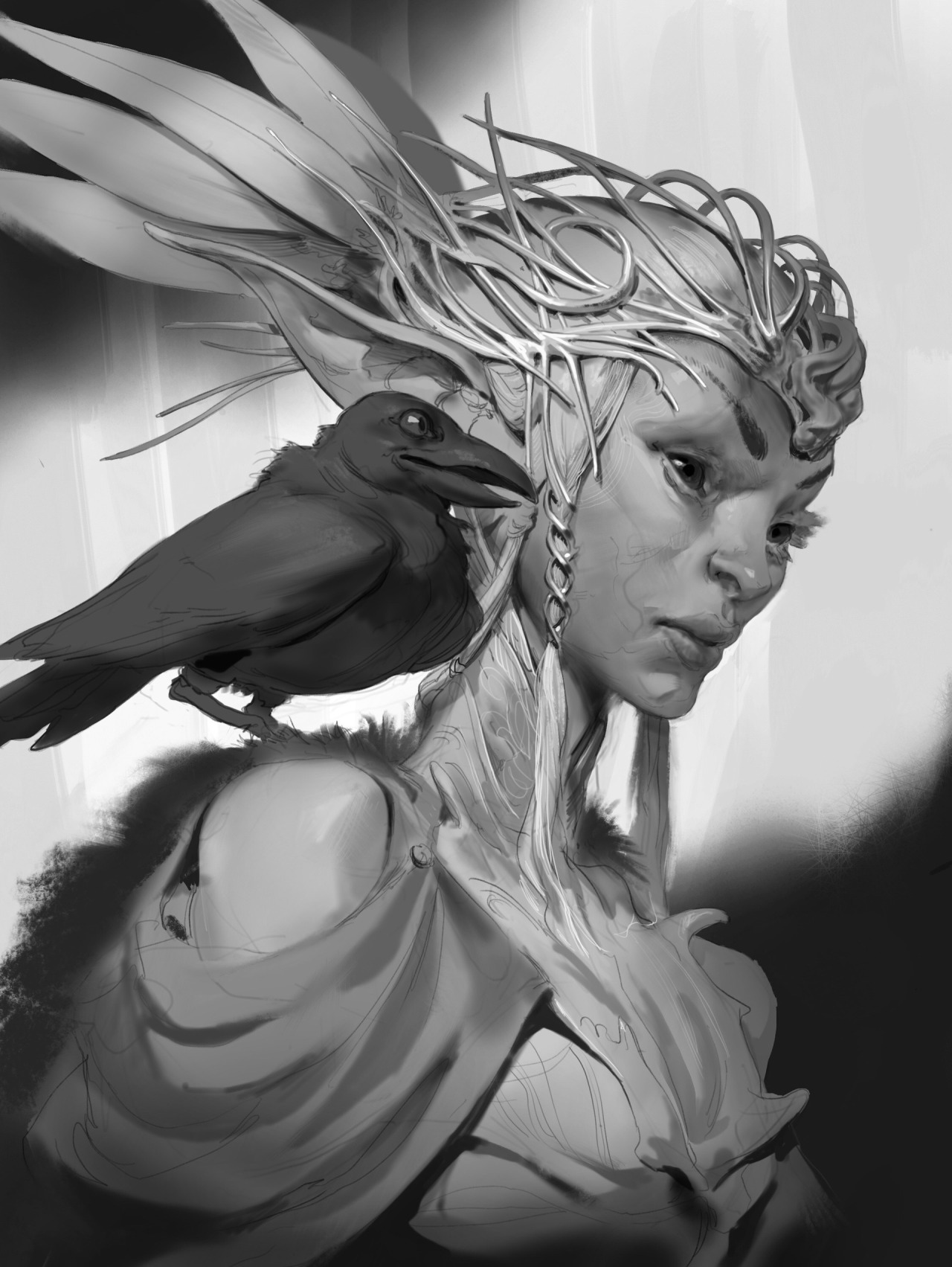Wood Elf
A Wood Elf is a subrace of elves commonly found in the wild and forested regions of Holos. Of the elves that dwell on the Material Plane, the wood elves appear to most diligently follow the life ways and cultural practices of their ancestors who once roamed the Feywild. Most wood elves in Auloa split from their high elf kin at the beginning of the Sundered Era, after the elven people's connection to the fey magic returned and the two groups broke away from one another over disagreements regarding the nature of this seemingly divine sign. With their unique culture and hidden forest villages, wood elves are the subject of great mystery, and speculation, and sometimes even fear, among the mortal races of Holos.
Basic Information
Anatomy
As with all elves, wood elves are characterized by their fey grace and fine features that make them seem decidedly ancient and arcane. They are slightly shorter than humans, ranging from under 5 feet to just over 6 feet tall. They are known for being slender and for seeming to carry less weight for their mass, with little to no difference between the sexes in terms of weight. Of the subraces, wood elves are generally the most fit and athletic, and rest comfortably between the stature of a high elf and a drow.
Wood elves are physically distinguished from the other elven races by their tawnier skin and dark hair. Many wood elves that dabble in fey magics have streaks of bright colors in their hair or eyes—sometimes even foliage or animal feathers or fur can be grown by those who deeply embrace the Old Magics.
Of the elves, wood elves have the easiest time growing body hair, though it usually does not appear until the final stages of their life. Wood elves share the tapered ears of the fey and see the length and shape of a ear to be a sign of virility. Ear piercings and decorations of feathers, tokens, and leafage commonly adore wood elf ears.
Genetics and Reproduction
Because of their long life spans, elves have the longest gestation period of any mortal, clocking in at around five years. Much of that time, an elven fetus remains in the embryonic stage of development. The elven fetuses require certain conditions to be met in order to grow to the proper stages. This includes the mother consuming important herbs, resting under a clear night's sky, and getting regular exercise. All of these activities are things that would be easy for the elf's ancestor to do in the Feywild, but present challenges in the Material Plane. Elf mothers rarely miscarry, instead the embryos are able to go into a stasis, waiting until the right conditions are met in order to advance in their stage of embryonic development.
Additionally, elf women have far fewer eggs than other mortal races. The average number of elf children is two, with twins being common and with seven total offspring being the maximum. This further constrains population growth and ensures that every child born to an elven family has a great deal of pressure to continue the species. Wood elves seem to be able to produce more offspring, perhaps because their traditions more closely resemble those of their fey ancestors.
Because of the complexity of elven reproduction, elves in the Material Plane have seen their numbers drastically decline over the past millennia leading to cultural shifts like elven purity standards and inter-community bride exchanges.
Growth Rate & Stages
Elves are the longest lived of the mortal races, regularly reaching 300 years old and some even living up to 500 years. The adolescent and subadult periods for elves is about twice as long as it is for humans, with elves reaching sexual maturity around age 30 and emotional maturity around age 50. Most communities of elves don't consider children to have achieved adulthood until age 40, upon which they are permitted to take spouses and leave the care of their parents.
Ecology and Habitats
Wood elves are most at home in areas of dense foliage and riotous nature. Coniferous, mixed temperate, deciduous forests are all ideal habitats for wood elves. Some communities can even be found in tropical jungles, such as the cloud elf communities of Hakoa. Wood elves have adapted well to this environment, being more fleet of foot than many other mortal races and able to move unencumbered by thick undergrowth. They also are experts at hiding amid the leaves and branches of their homes, giving them the ability to sneak around danger even when only lightly obscured by the nature around them.
Dietary Needs and Habits
While some wood elves do consume grain, most wood elf societies are hunter-gatherer groups or woodland herdsmen, taming and breeding passerine or giant elk mounts. They subsist on nuts, berries, leaves, tubers, fish, small animals, and big game; though wood elves are always conscious of not overwhelming an ecosystem with their hunting practices.
Additional Information
Geographic Origin and Distribution
Wood elves are found across Holos and on nearly every continent, save Teroa. Their most well known domains are the Mehilan in Auloa and the Bashari Timberlands in Nioa, as well as several large communities located in the jungles and forests of Iroa and Hakoa.
Perception and Sensory Capabilities
Wood elves have remarkable sensory abilities thanks to their fey heritage. They are fully proficient in Perception and can see in darkness up to 60 ft., which is exceptionally useful when hunting in the thick undergrowth of their native timberlands. Not even sleep impedes an elf's perception abilities, as they require only four hours of sleep per day in order to remain rested.
Civilization and Culture
Beauty Ideals
Wood elves share the tapered ears of the fey and see the length and shape of a ear to be a sign of virility. Ear piercings and decorations of feathers, tokens, and leafage commonly adore wood elf ears.
History
The wood elves once considered themselves to be one with their kin, the high elves, until the fallout of the Sundering Arcana. With the Sundering, the elves lost much of their material power and wealth, having the great Palladian Empire which they enthusiastically supported crumble before them. However, the Sundering also returned the elves's connection to the Feywild and to the magics of the Seelie and Unseelie Court. This revelation forced elves to consider whether to remain faithful to the Heavenly Council like they had been during the Palladian Era or take up their magic as their forebearers had and follow the animistic traditions of the Feywild. Those who decided to remain adherents to the Heavenly faith and the Palladian promises of civilization and progress became the high elves, while those who decided to return to the ways of the Fey became the wood elves.
The wood elves still lacked the innate, free-flowing magic of the eladrin or of the fey themselves, but their traditions adjusted to meet the needs of a fey society in the Material Plane. They abandoned the gods of the Heavenly Council and became animists and ancestral worshipers, seeing the divine in all things natural and filled with life. To be closer with these spirits, the wood elves abandoned the cities and towns of the fallen Palladians and returned to the wild places of the world and took up a hunter-gatherer lifestyle befitting their wild roots. They swore Oaths to the Ancients and created orders of green priests, tasked with looking to the spiritual health of their community and of their environment. Many began to follow the circles of the druids and started to worship the Mother of All Wilds, Acien Tali. Others forged pacts with the Archfey of the Seelie and Unseelie Courts in order to grow their knowledge and power.
This abandonment of the Palladian ways irked the high elves, who saw them as abandoning their destiny to help heal the Sundered world with their magic. A rivalry emerged between the two, fueled by wars and disagreements and they have remained fractured ever since. Conflicts continue to arise, and all seems born out of the question: why did magic abandon the elves during the Palladian Era and why did it return with the Sundering?
Genetic Ancestor(s)
Genetic Descendants
Origin/Ancestry
Fey
Lifespan
300-500 years
Average Height
4'8"-5'10"
Average Weight
100-140 lbs
Related Organizations
Related Ethnicities




Comments